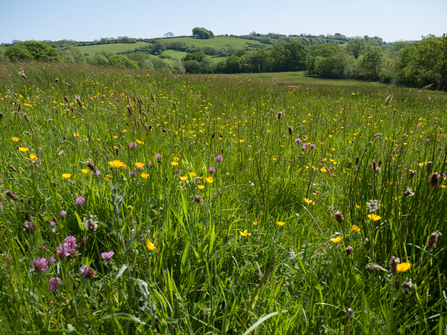Meadows are wonderfully colourful and exciting places for getting up close to wildlife. Saturday 1st July is National Meadows Day and The Wildlife Trusts are urging people to enjoy a meadow event or a stroll through one of the many buzzing, humming meadows cared for by volunteers and staff across the UK.
Unimproved grasslands - grasslands that are cared for using traditional farming methods - are the richest habitats for wildlife in the UK, supporting more endangered species than any other habitat: a fifth of all threatened species need unimproved grassland habitats. To take just one of thousands of species that thrive in meadows - the rare marsh fritillary butterfly depends on areas of flower-rich grassland to breed. The amazing variety of herbs, grasses and wildflowers attract pollinators searching for nectar – and this abundance of insects, in turn, attracts rare horseshoe bats and declining farmland birds, such as skylark.
Ellie Brodie, Senior Policy Manager of The Wildlife Trusts, says:
“Lowland meadows were formerly found across lowland England. Unfortunately, 97% have been lost, largely to agriculture or development since 1940 and there are less than 8,000 hectares left, mostly surviving as small individual fields on farms. These special places depend on sympathetic management, such as low-intensity grazing by livestock or horses, or mowing for hay. A successful meadow restoration can take a while - over 15 years for some of the species to establish and start to bloom. The Wildlife Trusts across the UK are doing all they can to help protect those that are left and to restore others through habitat enhancement, and by providing advice to farmers on wildlife-friendly farming methods such as conservation grazing techniques. In many counties Wildlife Trusts have saved some of the last remaining meadows and now manage these as nature reserves.
“We work with partners too, for example through Save Our Magnificent Meadows - the UK’s largest partnership project transforming the fortunes of vanishing wild flower meadows, grasslands and their wildlife. The project is targeting almost 6,000 hectares of wild flower meadows and grasslands in nine areas across the UK.”


